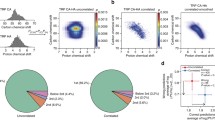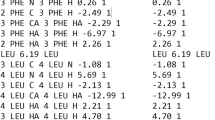Abstract
Protein structure determination by NMR can in principle be speeded up both by reducing the measurement time on the NMR spectrometer and by a more efficient analysis of the spectra. Here we study the reliability of protein structure determination based on a single type of spectra, namely nuclear Overhauser effect spectroscopy (NOESY), using a fully automated procedure for the sequence-specific resonance assignment with the recently introduced FLYA algorithm, followed by combined automated NOE distance restraint assignment and structure calculation with CYANA. This NOESY-FLYA method was applied to eight proteins with 63–160 residues for which resonance assignments and solution structures had previously been determined by the Northeast Structural Genomics Consortium (NESG), and unrefined and refined NOESY data sets have been made available for the Critical Assessment of Automated Structure Determination of Proteins by NMR project. Using only peak lists from three-dimensional 13C- or 15N-resolved NOESY spectra as input, the FLYA algorithm yielded for the eight proteins 91–98 % correct backbone and side-chain assignments if manually refined peak lists are used, and 64–96 % correct assignments based on raw peak lists. Subsequent structure calculations with CYANA then produced structures with root-mean-square deviation (RMSD) values to the manually determined reference structures of 0.8–2.0 Å if refined peak lists are used. With raw peak lists, calculations for 4 proteins converged resulting in RMSDs to the reference structure of 0.8–2.8 Å, whereas no convergence was obtained for the four other proteins (two of which did already not converge with the correct manual resonance assignments given as input). These results show that, given high-quality experimental NOESY peak lists, the chemical shift assignments can be uncovered, without any recourse to traditional through-bond type assignment experiments, to an extent that is sufficient for calculating accurate three-dimensional structures.



Similar content being viewed by others
References
Aeschbacher T, Schmidt E, Blatter M, Maris C, Duss O, Allain FH-T, Güntert P, Schubert M (2013) Automated and assisted RNA resonance assignment using NMR chemical shift statistics. Nucleic Acids Res. doi:10.1093/nar/gkt665
Altieri AS, Byrd RA (2004) Automation of NMR structure determination of proteins. Curr Opin Struct Biol 14:547–553
Baran MC, Huang YJ, Moseley HNB, Montelione GT (2004) Automated analysis of protein NMR assignments and structures. Chem Rev 104:3541–3555
Bartels C, Xia TH, Billeter M, Güntert P, Wüthrich K (1995) The program XEASY for computer-supported NMR spectral analysis of biological macromolecules. J Biomol NMR 6:1–10
Bartels C, Billeter M, Güntert P, Wüthrich K (1996) Automated sequence-specific NMR assignment of homologous proteins using the program GARANT. J Biomol NMR 7:207–213
Bartels C, Güntert P, Billeter M, Wüthrich K (1997) GARANT—a general algorithm for resonance assignment of multidimensional nuclear magnetic resonance spectra. J Comput Chem 18:139–149
Bhattacharya A, Tejero R, Montelione GT (2007) Evaluating protein structures determined by structural genomics consortia. Proteins 66:778–795
Folmer RHA, Hilbers CW, Konings RNH, Nilges M (1997) Floating stereospecific assignment revisited: application to an 18 kDa protein and comparison with J-coupling data. J Biomol NMR 9:245–258
Guerry P, Herrmann T (2011) Advances in automated NMR protein structure determination. Q Rev Biophys 44:257–309
Güntert P (1998) Structure calculation of biological macromolecules from NMR data. Q Rev Biophys 31:145–237
Güntert P (2009) Automated structure determination from NMR spectra. Eur Biophys J 38:129–143
Güntert P, Braun W, Wüthrich K (1991) Efficient computation of three-dimensional protein structures in solution from nuclear magnetic resonance data using the program DIANA and the supporting programs CALIBA, HABAS and GLOMSA. J Mol Biol 217:517–530
Güntert P, Mumenthaler C, Wüthrich K (1997) Torsion angle dynamics for NMR structure calculation with the new program DYANA. J Mol Biol 273:283–298
Herrmann T, Güntert P, Wüthrich K (2002a) Protein NMR structure determination with automated NOE assignment using the new software CANDID and the torsion angle dynamics algorithm DYANA. J Mol Biol 319:209–227
Herrmann T, Güntert P, Wüthrich K (2002b) Protein NMR structure determination with automated NOE-identification in the NOESY spectra using the new software ATNOS. J Biomol NMR 24:171–189
Ikeya T, Jee J-G, Shigemitsu Y, Hamatsu J, Mishima M, Ito Y, Kainosho M, Güntert P (2011) Exclusively NOESY-based automated NMR assignment and structure determination of proteins. J Biomol NMR 50:137–146
Jee J, Güntert P (2003) Influence of the completeness of chemical shift assignments on NMR structures obtained with automated NOE assignment. J Struct Funct Genom 4:179–189
Kainosho M, Torizawa T, Iwashita Y, Terauchi T, Ono A, Güntert P (2006) Optimal isotope labelling for NMR protein structure determinations. Nature 440:52–57
Koga N, Tatsumi-Koga R, Liu GH, Xiao R, Acton TB, Montelione GT, Baker D (2012) Principles for designing ideal protein structures. Nature 491:222–227
Liu GH, Shen Y, Atreya HS, Parish D, Shao Y, Sukumaran DK, Xiao R, Yee A, Lemak A, Bhattacharya A, Acton TA, Arrowsmith CH, Montelione GT, Szyperski T (2005) NMR data collection and analysis protocol for high-throughput protein structure determination. Proc Natl Acad Sci USA 102:10487–10492
Liu GOH, Huang YJ, Xiao R, Wang DY, Acton TB, Montelione GT (2010) Solution NMR structure of the ARID domain of human AT-rich interactive domain-containing protein 3A: a human cancer protein interaction network target. Protein Struct Funct Bioinfo 78:2170–2175
López-Méndez B, Güntert P (2006) Automated protein structure determination from NMR spectra. J Am Chem Soc 128:13112–13122
Malmodin D, Papavoine CHM, Billeter M (2003) Fully automated sequence-specific resonance assignments of heteronuclear protein spectra. J Biomol NMR 27:69–79
Rosato A, Bagaria A, Baker D, Bardiaux B, Cavalli A, Doreleijers JF, Giachetti A, Guerry P, Güntert P, Herrmann T, Huang YJ, Jonker HRA, Mao B, Malliavin TE, Montelione GT, Nilges M, Raman S, van der Schot G, Vranken WF, Vuister GW, Bonvin AMJJ (2009) CASD-NMR: critical assessment of automated structure determination by NMR. Nat Methods 6:625–626
Rosato A, Aramini JM, Arrowsmith C, Bagaria A, Baker D, Cavalli A, Doreleijers JF, Eletsky A, Giachetti A, Guerry P, Gutmanas A, Güntert P, He YF, Herrmann T, Huang YPJ, Jaravine V, Jonker HRA, Kennedy MA, Lange OF, Liu GH, Malliavin TE, Mani R, Mao BC, Montelione GT, Nilges M, Rossi P, van der Schot G, Schwalbe H, Szyperski TA, Vendruscolo M, Vernon R, Vranken WF, de Vries S, Vuister GW, Wu B, Yang YH, Bonvin AMJJ (2012) Blind testing of routine, fully automated determination of protein structures from NMR data. Structure 20:227–236
Schmidt E, Güntert P (2012) A new algorithm for reliable and general NMR resonance assignment. J Am Chem Soc 134:12817–12829
Schmidt E, Gath J, Habenstein B, Ravotti F, Székely K, Huber M, Buchner L, Böckmann A, Meier BH, Güntert P (2013) Automated solid-state NMR resonance assignment of protein microcrystals and amyloids. J Biomol NMR 56:243–254
Shen Y, Delaglio F, Cornilescu G, Bax A (2009) TALOS+: a hybrid method for predicting protein backbone torsion angles from NMR chemical shifts. J Biomol NMR 44:213–223
Ulrich EL, Akutsu H, Doreleijers JF, Harano Y, Ioannidis YE, Lin J, Livny M, Mading S, Maziuk D, Miller Z, Nakatani E, Schulte CF, Tolmie DE, Wenger RK, Yao HY, Markley JL (2008) BioMagResBank. Nucleic Acids Res 36:D402–D408
Williamson MP, Craven CJ (2009) Automated protein structure calculation from NMR data. J Biomol NMR 43:131–143
Acknowledgments
We thank Profs. G. Montelione and C. Arrowsmith of the Northeast Structural Genomics (NESG) consortium and the CASD-NMR project for providing the experimental data. We gratefully acknowledge financial support by the Lichtenberg program of the Volkswagen Foundation and the Deutsche Forschungsgemeinschaft (DFG).
Author information
Authors and Affiliations
Corresponding author
Electronic supplementary material
Below is the link to the electronic supplementary material.
Rights and permissions
About this article
Cite this article
Schmidt, E., Güntert, P. Reliability of exclusively NOESY-based automated resonance assignment and structure determination of proteins. J Biomol NMR 57, 193–204 (2013). https://doi.org/10.1007/s10858-013-9779-x
Received:
Accepted:
Published:
Issue Date:
DOI: https://doi.org/10.1007/s10858-013-9779-x




